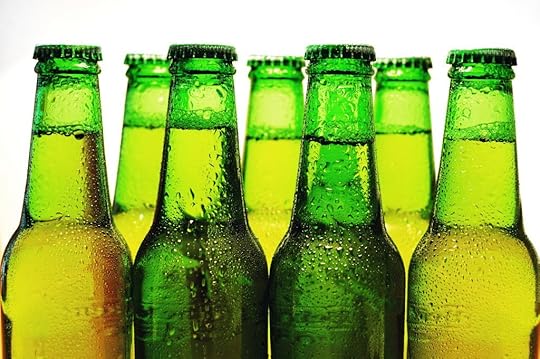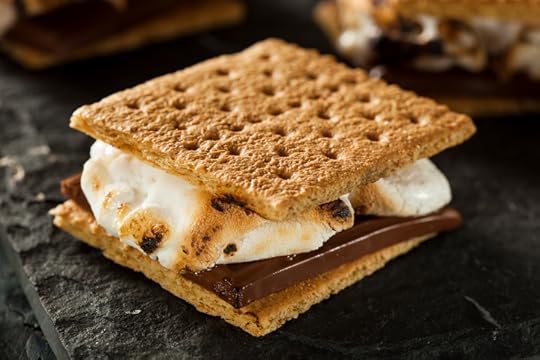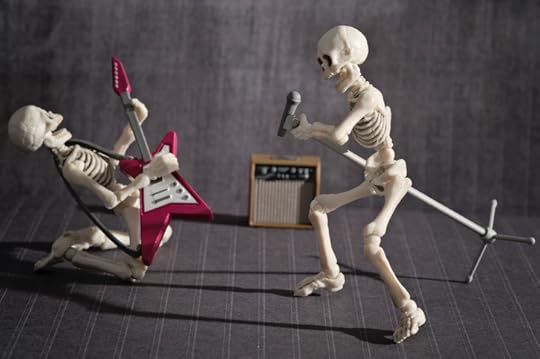Bathroom Readers' Institute's Blog, page 36
August 13, 2018
How is non-alcoholic beer brewed?

There are a lot of reasons to drink non-alcoholic beer—mostly because regular beer has alcohol in it, and lots of people don’t want to drink alcohol for personal, health, or religious reasons. Here’s how they make the beer without the booze.
It starts out the same.
Breweries start making non-alcoholic beer in exactly the same way they make non-non-alcoholic beer. To simplify immensely: Grains (such as wheat and rice) are cooked at a near-boiling temperature for a while (that’s called a mash), and the liquid is siphoned off (the wort), which is then boiled. After that, flavoring agents like hops are added and the beer ferments, which adds the carbonation.
Then things get hot.
At this point, the methods for beer and “near beer” change. Regular beer is placed into bottles, cans, or kegs. This allows it to age, and for the alcohol to continue developing. Non-alcoholic beer requires a few more steps to prevent any more alcohol from coming up as well as to eliminate what has already come about naturally. One way it’s done is heating. With this method, fermented beer gets heated to a temperature of beer’s boiling point of 173°F…and kept there. The alcohol level is measured until it levels off at a maximum of 0.5 percent alcohol by volume (ABV).
But heat kills flavor.
Unfortunately, heating up the beer also cooks off a lot of the flavor that had developed, so some breweries prefer to use a process called vacuum distilling. Placing the beer in a vacuum chamber can artificially lower the boiling point to 120 degrees—less heat means less flavor loss.
Some use “reverse-osmosis” instead.
Breweries may also use “reverse-osmosis” to get the alcohol out. It preserves flavor because no heat is used. First, the beer mixture passes through an ultra-fine filter, separating it into water/alcohol/trace amounts of acids, and a syrup of sugars and flavoring agents. The alcohol is then chemically distilled out of the water/alcohol/acid mix, and what’s left is added back into the sugary stuff.
And finally, the bubbles.
All that’s left to do now is add the bubbles—those come from carbon dioxide injected into the beer just before bottling.
The post How is non-alcoholic beer brewed? appeared first on Trivia Books and Facts | Uncle John's Bathroom Reader.
August 12, 2018
The Colorful Lives of Game Show Hosts
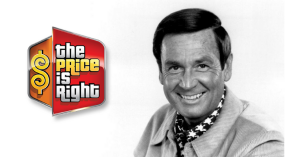
Come on down…and check out these stories about the off-stage lives of famous TV game show hosts.
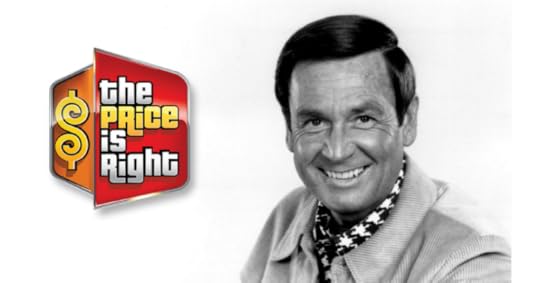
Bob Barker
Longtime The Price is Right host Bob Barker is well known for his end-of-show sign-off, asking viewers “to help control the pet population and have your pets spayed or neutered.” Barker was an outspoken animal rights activist, ever since he became a vegetarian in 1979. He did so because his wife, Dorothy Jo, had given up meat, too, and when she died in 1981, he decided to take on her passionate cause as his own. So much so that in 1987, he quit his 20-year gig as host of the televised Miss USA Pageant. He asked organizers to stop giving away fur coats as prizes; they refused, so he resigned.
Bob Eubanks
Before he found the profession for which he was clearly born to do—headlining game shows—The Newlywed Game host Bob Eubanks was a top amateur athlete. As a teenager in the 1950s, he won multiple national roller skating championship events, and almost got to show off his stuff in the Olympics, which was reportedly set to add roller skating as an official event. That ultimately didn’t happen, so Eubanks went into the entertainment business instead.
Peter Tomarken
Tomarken was a constant presence on daytime TV in the 1980s, hosting several game shows, notably Press Your Luck (“no Whammies!”). He was also a constant presence on the Southern California medical transport circuit. Tomarken was a licensed pilot, and when he wasn’t giving away fabulous prizes to contestants, he was flying his plane for Angel Flight West, a charity that airlifted sick or injured people free of charge. (Tomarken was on his way to transport a San Diego cancer patient in 2006 when his plane crashed into the Santa Monica Bay, ending his life at age 64.)
Gene Rayburn
Former Broadway actor Gene Rayburn found his niche as the host of Match Game in the 1970s, presiding over a panel of often soused B-list celebrities including Brett Somers and Charles Nelson Reilly. In its Rayburn-hosted iteration, Match Game ran from 1973 to 1982. A reboot was planned for the 1985-86 season, but while the show was in pre-production, an Entertainment Tonight “celebrity birthday” segment wished a happy 68th to Rayburn. What’s so bad about that: Rayburn had been lying about his age for decades, claiming to be much younger than he actually was. The Match Game revival was canceled, and Rayburn says the mini-scandal—and the age discrimination that came with it—prevented him from finding work.
Richard Dawson
Family Feud host Richard Dawson, met his wife, Gretchen Johnson…on an episode of Family Feud. In 1981, after her family completed a multiple episode run, Dawson asked Johnson if he could call her sometime. She said sure, and that he could find her number in her show application. Dawson called Johnson three days a row and she never answered, so he thought she’d given him a fake number. It turns out, she’d had her wisdom teeth removed and wasn’t up to answering the phone. When she did, he invited her to his L.A. home, where he made her Beef Wellington.
The post The Colorful Lives of Game Show Hosts appeared first on Trivia Books and Facts | Uncle John's Bathroom Reader.
August 10, 2018
S’more-igins

Have you found the time this summer to get out to the woods and make yourself a s’more? In honor of National S’mores Day, here’s the story of how they were invented, along with some background on some of the essential ingredients for the mighty s’more.
S’MORES
It’s not like one person put chocolate and roasted marshmallows between two graham crackers, held a press conference, and announced their concoction to an appreciative world. Food historians say it likely became a popular campfire treat when the modern idea of recreational camping first took off in the 1920s. The first published recipe for s’mores reflects that notion: Credited to Girl Scout leader Loretta Scott Crew, her instructions for the by then common “some mores” were included in the 1927 book Tramping and Trailing with the Girl Scouts. (And yes, they were called “some mores” because few people can stop themselves at just one.)
MARSHMALLOWS
Marshmallows are even older than that half a bag of marshmallows you’ve got in your pantry left over from when you made Rice Krispies Treats a few months ago. They date to ancient Egypt, where they started as the sticky sap of the mallow plant mixed with honey and nuts for a sweet and gooey treat. Europeans still made them that way until the 19th century which is when confectioners in France replaced the honey and nuts with sugar and egg whites. These marshmallows became extremely popular in Europe and the U.S., leading candy makers to replace the final original ingredient—out went the mallow and in came cheaper and more plentiful gelatin. Eventually the sugar got replaced with corn syrup, completing the evolution of the modern marshmallow.
GRAHAM CRACKERS
The graham cracker is a unique concoction: sweet like a cookie (but not too sweet) and flat and crunchy like a cracker. Presbyterian minister Sylvester Graham invented the first iteration of the graham cracker in the early 1800s, a ready-to-eat, easy-to-make staple that featured prominently in what became known as “The Graham Diet.” His graham cracker consisted of unbleached flour, wheat germ, and wheat bran. Decades later, sugar and spices were added because the Graham Diet forbade those things…along with meat and white flour. Graham advocated eating like this as a way to eradicate lust and “impure thoughts.”
The post S’more-igins appeared first on Trivia Books and Facts | Uncle John's Bathroom Reader.
August 7, 2018
So Long, Brookstone

It would seem that Brookstone itself could use a sit in one of its massage chairs about now. The mall store, famous for its expensive vibrating leather chairs and ever-changing assortment of wireless speakers and other gadgets has filed for bankruptcy and will close its stores. Here are some of the oddest items that the chain, founded in 1965 as a catalog operation by Pierre de Beaumont, ever peddled.

Fizzics Waytap Draft Beer System
This $100 device promised instant draft beer at home. Did you pour in the ingredients or use some kind of special pod to make instant beer? Not exactly. It required users to put a can or bottle of store-bought beer in the back and “science” would take it taste like a beer on tap.
Devil Horn Headphones with Removable Horns
These red and yellow headphones look just like cartoon devil horns, like what a person would wear on Halloween. (The ears even glow yellow when in use.) Also, if you felt ridiculous, you could take the horns off and wind up with a pair of $150, novelty-free headphones.
Solafeet
Brookstone always sold an array of electronic foot massagers and foot baths. This looked like one of those, except instead of offering water and stimulation, it sported powerful lights that gave feet a nice suntan.
Bluetooth Pom-Pom Beanie
It may look like a warm, fuzzy, wool winter hat, and it is that. But try not to get it too wet with snow and rain because there are wireless headphones embedded on the inside.
Internet Message Center
This Wi-Fi enabled device displayed a user’s incoming emails, pertinent tweets, and text messages. You know, like a smartphone. Or a computer.
Golf Ball Waterglobe
Ironically, one can’t very well golf in the snow. But you can let visitors to your office or den know how much you love golf with this $25 snow globe that has an oversized golf ball and falling flakes of fake snow in it.
Sightmark Ghost Hunter Night Vision Binocular
Finally, “night vision” goggles for regular consumers, similar to the ones they use in the military. Utilizing the combined power of (among other things) infrared technology and AAA batteries, users could use it to see in the dark well enough to, as the name of the product may suggest, track down spirits and specters.
The post So Long, Brookstone appeared first on Trivia Books and Facts | Uncle John's Bathroom Reader.
August 6, 2018
Teams That Folded Before They Took the Field

Sports fans are used to their favorite team having ups and downs over the years. In a way, these teams never let their supporters down…because they fell apart before playing a single game.
Basketball in Buffalo
In 1949 the two most promising pro basketball leagues in America merged to become today’s NBA: the National Basketball League, and the Basketball Association of America. Some BAA teams made the move, including the Boston Celtics and the New York Knicks. Others didn’t, such as the St. Louis Bombers and the Providence Steamrollers. And then there is the odd case of the team mysteriously listed in sports history books as “BAA Buffalo.” League officials announced in June 1946 that the BAA would expand to Buffalo, but team leaders never got their act together. With no progress made after two years, the BAA revoked the franchise in 1948. (Buffalo would finally get an NBA team in 1970, with the expansion Buffalo Braves…who became the San Diego Clippers just eight years later.)
The first pro basketball team in Indianapolis
Amazingly, there was a Basketball Association of America team that was somehow even more short-lived than the Buffalo franchise. A planned team in the basketball-mad city of Indianapolis was supposed to take the court for the BAA’s first season in 1946, but folded before the season began, meaning that it was born and died before any BAA team played. (The BAA fielded the Indianapolis Jets in 1948, and today the Indiana Pacers play in the NBA.)
Chicago’s USFL team
Beginning play in 1983, the USFL was a professional football league that competed with the NFL, offering a similarly high level of play, and featuring teams primarily based in cities that didn’t have NFL teams at the time, such as Birmingham, Phoenix, and San Antonio. The league struggled financially over its first three seasons as a spring/summer league, but tackled itself when it tried to move to fall—to go head-to-head against the dominant NFL. The league folded before that fated 1986 season could even begin. Eight teams had to cancel their games, including a new, unnamed team in Chicago to replace the Chicago Blitz, which folded in 1984. At the time of the league’s dissolving, the Chicago squad hadn’t yet secured access to a home stadium, having been denied the right to play at both Solider Field (home of the NFL’s Chicago Bears) and Comiskey Park (home of baseball’s Chicago White Sox).
The post Teams That Folded Before They Took the Field appeared first on Trivia Books and Facts | Uncle John's Bathroom Reader.
August 3, 2018
Can Dental Work Really Pick Up Radio Broadcasts?

It’s a notion first put forth—and explored—by television…but that doesn’t mean it isn’t true.
It’s been use as a plot device on numerous sitcoms. In fact, Uncle John got the idea for this piece when he was watching an episode of The Partridge Family the other day—Laurie had just gotten fitted for braces, and she kept hearing mysterious music. Turns out the metal in her mouth was picking up signals and broadcasting to an audience of one. On other sitcoms, it’s headgear that brings in the swingin’ sounds, or metal fillings in cavities. But is there any truth to it?
When did the idea first come about?
The idea probably hit the public consciousness in the early ‘70s, around the time that Partridge Family episode aired. TV legend Lucille Ball was a guest on The Dick Cavett Show and told a strange story in which she claimed to have helped capture a Japanese spy back during World War II. In 1942, Ball was filming the movie musical Du Barry Was a Lady at MGM Studios in California…where many feared an attack by Japan could come along any day. One night, she drove home, she heard music…but the radio wasn’t on. The music got gradually louder, and Ball realized that it was coming out of her mouth. She didn’t tell her husband, Desi Arnaz, because she thought it made her sound crazy. But she did tell actor Buster Keaton on set the next day—as a joke (he was a comedian, after all) he told her she must be picking up radio signals.
Morse Code
Ball kind of forgot about until about a month later…when her mouth picked up rapid Morse Code dashes and dots. She told MGM’s security department about it, who in turn called the FBI, who found a secret Japanese-run radio station operated by a spy, right there in Los Angeles. So says Lucy.
The MythBusters connection
Another TV entity enters into the story, too. The team from MythBusters looked into the science behind the story. They discovered that it is feasible to pick up radio signals through a filling, but only if the conditions are right. Gold and amalgam fillings placed inside an authentic human skull didn’t work, but they determined that Morse code could be captured due to a cell reaction between silver fillings and saliva.
The post Can Dental Work Really Pick Up Radio Broadcasts? appeared first on Trivia Books and Facts | Uncle John's Bathroom Reader.
August 2, 2018
TV Taught Me to Sue My Prom Date

These kids today! Things would be a lot better if they had those preachy ABC Afterschool Specials to give them a moral compass. Okay, none of that is true, but here are some of silliest, most over-the-top Afterschool Specials from the ‘70s, ’80, and ‘90s.
Fast Forward
In this very dark take on It’s a Wonderful Life, a teen experimenting with alcohol gets a glimpse into his future, if he keeps on drinking. The good news: He grows up into Gerald McRaney, from TV’s Simon & Simon. The bad news: He also becomes a homeless alcoholic.
Teenage Confidential
This one might have geared more toward the parents of teens than the usual teen audience. The plot: a couple of overprotective parents are so worried about their teenage daughter’s comings and goings that they hire a private detective to follow her around and report on her activities. (They ultimately learn to trust their daughter and give her some space.)
Stood Up!
Plucky teenager Becky is really looking forward to her high school prom. But then, guess what happens? She gets stood up—her date cruelly cancels on her at the last minute. She missed all the fun of what was supposed to be a big night. What’s a plucky teenager to do? Becky takes the guy to court is what.
Daddy Can’t Read
A teenager named Alison takes it upon herself to increase the literacy rates among those who work at a factory with her father. Dad is mysteriously dead set against Allison’s efforts. (That reason? Read the title—he’s secretly illiterate, too.) For some reason, Daddy Can’t Read also features a cameo from pop superstar Michael Jackson as himself.
The Day My Kid Went Punk
In this dramedy about exploring one’s identity, a teenage musician tries to differentiate himself from his peers by adopting the “punk rocker” look. It’s worth noting that this special was made in 1987, a good decade after people stopped dressing like punk rockers.
The post TV Taught Me to Sue My Prom Date appeared first on Trivia Books and Facts | Uncle John's Bathroom Reader.
August 1, 2018
The Great Toilet Paper Debate

We get a lot of letters here at BRI headquarters, and recently longtime reader Robert W. wrote in with a suggestion: Research, describe, and hopefully settle the most important issue of our time: Which is the “proper” way to load toilet paper—coming off the top, or the bottom?
Aesthetics
Whether you have the paper coming over the top or out from underneath depends largely on aesthetics. Hotels, for example, almost universally go “over.” Why? So housekeepers can make that fancy little triangle fold at the edge. If that was attempted on an “under” roll, it would just hang out unattractively…and maybe even drag on the floor, which is gross.
Who prefers “under” over “over”?
Who prefers “under” over “over”? Not many of us. In a 2010 survey of 1,000 people by the company that makes Cottonelle toilet paper, 72 percent of Americans prefer over, vs. only 28 percent under. A more shocking result of the survey: 27 percent of “over” aficionados are so devoted to their cause that they admit flipping a roll at a friend’s house to the “better” way.
Practical concerns
Practical concerns may also determine why “over” is the preferred method. Toilet paper companies picture their products that way because it effectively shows off patterns, designs, and “ripples.” Also, if a person is in a hurry, over-the-roll paper is much easier to, well, grab, than if it’s going the other way.
“Under” has benefits
“Under” has its benefits, too. The loose edge can be hidden, which can be visually pleasing as well as making it harder for mischievous kids or pets to unroll the whole thing onto the floor. Drivers of bathroom-equipped RVs also attest that they go for the “under” style, because the roll doesn’t unroll as much when the vehicle is moving.
How the inventor wanted it hung
Modern inventions aren’t usually just the result of one person concocting the technology and earning a patent. The toilet developed over centuries, but the toilet paper roll has remained pretty much unchanged since 1891, when inventor Seth Wheeler received U.S. patent #459516A for “Wrapping or Toilet Paper Roll.” Inventors must submit diagrams of their innovation, and Wheeler did that. And it’s there that we can determine the true and correct way to hang a toilet paper roll, and it’s how the inventor wanted us to do it. Wheeler’s images show the paper coming over the top of the role. Mystery solved!
The post The Great Toilet Paper Debate appeared first on Trivia Books and Facts | Uncle John's Bathroom Reader.
July 31, 2018
Tonight on…”Not the Cosby Show”?
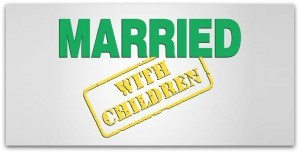
Would these popular or classic TV shows have been popular or classic TV shows if they’d gone with their original title ideas? Maybe not.
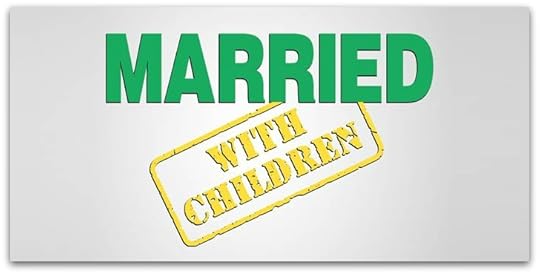
Not the Cosby Show
When Married…with Children hit TV in 1987 as one of the first ever shows on the Fox Network, the family sitcom was radically different than contemporary sticky-sweet sitcoms, like Growing Pains and The Cosby Show. The family was dysfunctional and just barely scraping by, the polar opposite of The Cosby Show. So much so, it had the working title Not the Cosby Show.
Surgeons
Grey’s Anatomy is a pretty clever title for a medical show. The 19th century medical textbook Gray’s Anatomy is still widely used, and the lead character on the show is named Meredith Grey. Had that connection not occurred to the show’s producers, they would’ve gone with the boring, first idea: Surgeons.
The Second Fattest Housewife in Westport
The generically-titled American Housewife is a present-day hit for ABC, a comedy about a single-income family—dad is a college professor, mom is a full-time homemaker with three precocious kids. They live in the extremely wealthy, at times superficial city of Westport, Connecticut. That, and star Katy Mixon’s non-beanpole body frame is why the show was originally titled The Second Fattest Housewife in Westport.
Chicks and D****
Since it ran for seven seasons, the title New Girl became increasingly inaccurate. The title initially referred to how main character Jess Day (Zooey Deschanel) striking out on her own after breaking up with a cheating boyfriend and moving into an L.A. loft with a bunch of guys. Original title: Chicks and D****.
Cool
What’s the one word you could use to describe Fonzie, from TV’s Happy Days? Probably “cool,” right? Cool was show creator Garry Marshall’s first choice for the title, until a person in a test audience thought it sounded like “a brand of cigarette.”
Owl Stretching Time
Monty Python’s Flying Circus is a silly, absurd title befitting a silly, absurd sketch comedy show made by a bunch of silly, absurd British sketch comedians. The Monty Python troupe wanted to call their BBC showcase Owl Stretching Time.
Lenny, Penny, and Kenny
The title The Big Bang Theory doesn’t have much to do with the show’s content, other than the fact that it’s a scientific term and the show is about the personal lives of Cal Tech scientists Leonard and Sheldon and their neighbor, Penny. Creators Bill Prady and Chuck Lorre first went with the title Lenny, Penny, and Kenny before changing it (and changing “Lenny” and “Kenny” to “Leonard” and “Sheldon.”)
The Hillbillies of Beverly Hills
Little things mean a lot. The Beverly Hillbillies was nearly titled The Hillbillies of Beverly Hills.
The post Tonight on…”Not the Cosby Show”? appeared first on Trivia Books and Facts | Uncle John's Bathroom Reader.
July 30, 2018
Whatever Happened to the Guy from Loverboy? Nobody Knows
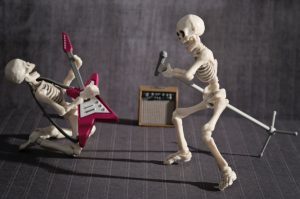
Some rock stars fade into obscurity, what with changing trends and tastes. Others fade into oblivion. Here are some once-popular musicians who disappeared off the face of the Earth.
The bassist from Loverboy
If you listen to the radio, you’ve probably heard Scott Smith’s legacy very recently. As the original bassist for the Canadian band Loverboy, Smith played on classic rock staples such as “Turn Me Loose” and “Working for the Weekend,” a Friday afternoon standard. Smith stayed with the group past its heyday…up until his mysterious disappearance in November 2000. After playing at a diabetes research benefit in Vancouver, Smith and some friends took off in his sailboat for Mexico. Near San Francisco, they hit a storm which produced 20-foot-high waves. One of them knocked Smith off the deck, and into the water. A Coast Guard search turned up nothing, and neither did a private search. Smith was 45 years old; his body was never recovered.
The Britpop guitarist
Richey Edwards wasn’t the lead singer of the edgy, 1990s British alternative rock (or “Britpop”) band the Manic Street Preachers, but he was certainly the star—a moody, good-looking guitarist who wrote a lot of the band’s lyrics…many of them about his depression. That’s why fans, friends, and family feared the worst when Edwards vanished in February 1995. Scheduled to fly to the U.S. with Manic Street Preachers singer James Dean Bradfield, Edwards disappeared from his hotel room, and his car was found abandoned by a U.K. bridge. Edwards never turned up, dead or alive, and he was declared legally dead in 2008.
The singer-songwriter that was ahead of her time
In the 1960s, folk-powered singer-songwriters like Bob Dylan and Joan Baez brought a rawness and poetry to both mainstream music and the rising counterculture moment. Ahead of seven those pioneers was 1950s musician Connie Converse. She played the same Greenwich Village clubs as later folkies would, but she never found mainstream fame or success, outside of a 1954 performance on CBS’s The Morning Show. She quit music for good and got on with her life in 1961. The next big moment in Converse’s life came in 1974. She turned 50, told her friends she was going to make a new start, and drove out of town. She was never heard from again. In wasn’t until 2009 that demo recordings she made were released…to wide acclaim.
The post Whatever Happened to the Guy from Loverboy? Nobody Knows appeared first on Trivia Books and Facts | Uncle John's Bathroom Reader.

